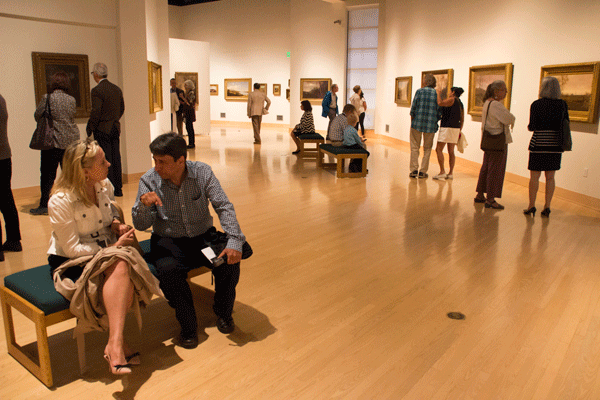
The Samuel Dorsky Museum of Art hosted a panel discussion on their current exhibition, “Jervis McEntee: Painter-Poet of the Hudson River School” in the Student Union Building on Sunday, Sept. 13.
The Dorsky’s Jervis McEntee show is the first ever exhibition entirely dedicated to his work. This groundbreaking historical event was even covered in The New York Times.
The conversation was moderated by Director of the Dorsky Sarah J. Pasti, filling in for William Rhoads who could not attend. The panelists included SUNY New Paltz Chair and associate professor of art history Kerry Dean Carso, Franklin and Marshall College professor David Schuyler and curator of the exhibit Lee A. Vedder.
According to Pasti, for every exhibition the Dorsky Museum organizes, they utilize various programs that correlate with the show. They believe in the importance of not only displaying the artist’s work, but also providing an opportunity for people to learn more about the artist.
“As a public institution our goal is really to educate,” Pasti said.
She said that the museum usually holds a panel discussion with the artist, but in cases like this where the artist is deceased they gather a variety of experts on the artist.
The event commenced with individual PowerPoint presentations on McEntee by each of the three panelists. Vedder broke the ice with a slideshow displaying his different works, which demonstrated the metamorphosis of McEntee’s career through his 20 years as a landscape painter.
“The idea for me was to really explore his evolution as an artist,” Vedder said.
Deep contemplative sighs filled the room every time she switched slides, revealing a new work of art. “Autumn Reverie” and “Evening Landscape” received the most admiration. The muted yellows and grays of McEntee’s late fall scenes seemed to enthrall the viewers.
Carso followed suit with a lecture on McEntee’s juxtaposition of nature and industry in his work. According to Carso the painting, “Danger Signal” symbolized the industrial revolution, while “Christmas Longing” represented McEntee’s nostalgic romantic longing for nature.
Schuyler closed the show with a discussion on the significance of McEntee’s work. He said that McEntee focused on intimate scenes in nature rather than panoramic fiery autumnal views.
“He really stamped his individuality onto his work. His paintings were poems,” Schuyler said.
An open discussion between panelists and audience participants concluded the event. The conversation ranged from questioning why McEntee wasn’t as successful as his fellow peers, to how he got his artistic supplies.
Local landscape painter and a guest educator at the Dorsky Museum Kevin Cook attended the event and considers McEntee to be one of his heroes. Cook believes that McEntee was one of the few landscape painters who truly stamped his own personality onto his pieces.
“The landscape is kind of a vehicle for me to talk about my own feelings or emotions,” Cook said.
“Jervis McEntee: painter–poet of the Hudson River School” will remain in the Dorsky until Sunday, Dec. 13.
